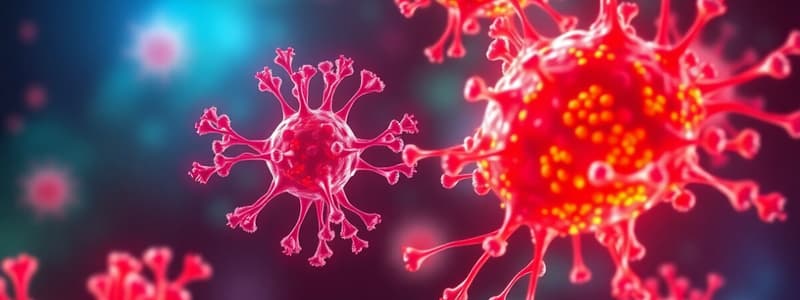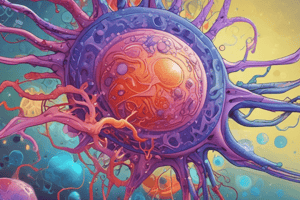Podcast
Questions and Answers
What is the role of IL-2 in relation to T lymphocytes?
What is the role of IL-2 in relation to T lymphocytes?
- It acts as a death signal for T lymphocytes.
- It inhibits the proliferation of T lymphocytes.
- It stimulates the survival and proliferation of T lymphocytes. (correct)
- It solely promotes the differentiation of naive T cells.
Which IL-2 receptor complex is expressed by resting T lymphocytes?
Which IL-2 receptor complex is expressed by resting T lymphocytes?
- IL-2Rβγ complex (correct)
- IL-2Rαβγ complex
- IL-2Rγc complex
- IL-2Rα complex
Which factor leads to the expression of the IL-2Rα chain in T cells?
Which factor leads to the expression of the IL-2Rα chain in T cells?
- Activation by antigen and costimulators (correct)
- Aging of T cells
- Deprivation of nutrients
- Inhibition by cytokines
What characteristic is associated with the high-affinity IL-2Rαβγ complex?
What characteristic is associated with the high-affinity IL-2Rαβγ complex?
How does IL-2 influence regulatory T cells?
How does IL-2 influence regulatory T cells?
What happens to most effector T cells after encountering an antigen and costimulation?
What happens to most effector T cells after encountering an antigen and costimulation?
Which cytokine is important in the structure of its trimeric receptor?
Which cytokine is important in the structure of its trimeric receptor?
What is a significant consequence of IL-2 receptor expression in activated T cells?
What is a significant consequence of IL-2 receptor expression in activated T cells?
What is the primary role of dendritic cells in T lymphocyte activation?
What is the primary role of dendritic cells in T lymphocyte activation?
What distinguishes T-cell epitopes from B-cell epitopes?
What distinguishes T-cell epitopes from B-cell epitopes?
Which process occurs first in the T cell response sequence?
Which process occurs first in the T cell response sequence?
What is the main source of interleukin 2 production?
What is the main source of interleukin 2 production?
Which of the following roles does interleukin 2 play in T lymphocyte activation?
Which of the following roles does interleukin 2 play in T lymphocyte activation?
What is the function of CTLA-4 in T lymphocyte activation?
What is the function of CTLA-4 in T lymphocyte activation?
What distinguishes helper T lymphocytes from killer T lymphocytes?
What distinguishes helper T lymphocytes from killer T lymphocytes?
Which mechanism is used by killer T lymphocytes to eliminate target cells?
Which mechanism is used by killer T lymphocytes to eliminate target cells?
What can contribute to granuloma formation in certain diseases?
What can contribute to granuloma formation in certain diseases?
Which statement accurately describes T-cell activation?
Which statement accurately describes T-cell activation?
Flashcards
Antigen-Presenting Cells (APCs)
Antigen-Presenting Cells (APCs)
Specialized immune cells that present antigens to T lymphocytes, initiating immune responses.
Cytotoxic T Lymphocytes (CTLs)
Cytotoxic T Lymphocytes (CTLs)
A type of immune cell that directly recognizes and attacks infected or cancerous cells.
Helper T Lymphocytes (Th cells)
Helper T Lymphocytes (Th cells)
A type of immune cell that helps activate other immune cells, such as macrophages and B cells. They come in different subtypes with specific functions.
Apoptosis
Apoptosis
Signup and view all the flashcards
Regulatory T Lymphocytes (Tregs)
Regulatory T Lymphocytes (Tregs)
Signup and view all the flashcards
Interleukin-2 (IL-2)
Interleukin-2 (IL-2)
Signup and view all the flashcards
CTLA-4
CTLA-4
Signup and view all the flashcards
T cell Activation
T cell Activation
Signup and view all the flashcards
CTL Killing Mechanism
CTL Killing Mechanism
Signup and view all the flashcards
Granuloma
Granuloma
Signup and view all the flashcards
What is the role of IL-2 in immune responses?
What is the role of IL-2 in immune responses?
Signup and view all the flashcards
How does the affinity of IL-2 for its receptor change?
How does the affinity of IL-2 for its receptor change?
Signup and view all the flashcards
What triggers the formation of the high-affinity IL-2 receptor complex?
What triggers the formation of the high-affinity IL-2 receptor complex?
Signup and view all the flashcards
What are the main functions of IL-2 in immune regulation?
What are the main functions of IL-2 in immune regulation?
Signup and view all the flashcards
What happens to T cells after activation?
What happens to T cells after activation?
Signup and view all the flashcards
What are memory T cells and why are they important?
What are memory T cells and why are they important?
Signup and view all the flashcards
What is the linear model of memory T cell differentiation?
What is the linear model of memory T cell differentiation?
Signup and view all the flashcards
How can memory T cells be distinguished from other T cells?
How can memory T cells be distinguished from other T cells?
Signup and view all the flashcards
Study Notes
Cell-Mediated Immunity: Activation and Effector Mechanisms
- Dendritic cells are primarily responsible for antigen presentation to T lymphocytes.
- Dendritic cells take up antigens in the skin and transport them to draining lymph nodes.
- Antigen presentation occurs in T-cell areas of lymph nodes.
- T cell activation is dependent upon antigen recognition and costimulation.
- T cells proliferate and differentiate upon activation, leading to effector cells.
- Effector T cells migrate to sites of infection or inflammation.
- Migration of T lymphocytes to lymph nodes involves several steps including L-selectin binding, rolling interaction, chemokine activation and firm adhesion.
- T lymphocytes circulate through lymph nodes, searching for specific antigens.
- T cell activation results from antigen recognition and costimulation.
B-cell Epitopes
- B-cell epitopes can be peptide, polysaccharide or nucleic acid structures.
- B-cell epitopes are recognized directly without antigen presentation.
- B-cell epitopes can be linear or conformational.
T-cell Epitopes
- T-cell epitopes are peptide structures.
- T-cell epitopes are recognized with the help of antigen-presenting cells.
- T-cell epitopes are only of linear type.
Sequence of Events in T Cell Responses
- Activation of macrophages and other cells, leading to inflammation.
- T cell activation by antigen in lymphoid tissues.
- CD4+ T cell differentiation into various subtypes.
- CD8+ T cell differentiation into cytotoxic T lymphocytes (CTLs).
- CTLs and memory cells develop after antigen exposure and activation.
- Production of memory cells to provide a faster response to subsequent encounters with the same antigen.
- Cytotoxic T cells eliminate infected or cancerous cells.
- The sequence involves antigen recognition, lymphocyte activation, proliferation, and differentiation into effector and memory cells.
Role of Interleukin 2
- Activated T cells produce interleukin-2 (IL-2).
- IL-2 stimulates the survival, proliferation and differentiation of other activated lymphocytes such as T-cells, B-cells and NK cells.
- IL-2 promotes the survival and function of regulatory T cells.
Different Messages of Antigen-Presenting Cells to T Lymphocytes
- MHC class II molecules present antigens in lymphoid tissues.
- Costimulatory molecules (B7.1 and B7.2) are crucial for T cell activation.
- Cytokines (IL-6, IL-12, TGF-β, IL-4) further direct differentiation to different T helper subtypes.
- The activated T cell receives multiple signals from the antigen and the antigen-presenting cell.
The Role of CTLA-4
- CTLA-4 binds B7 more strongly than CD28 and transmits inhibitory signals.
- CTLA-4 regulation of T cell activity is essential to prevent excessive immune responses.
Therapeutic Use of CTLA-4 Inhibition
- CTLA-4-Ig inhibits T cell activation by binding B7.
- Blocking B7 signalling with CTLA-4-Ig mitigates or inhibits immune activation against transplantation or tumor cells.
Different Subtypes of T Lymphocytes
- CD8+ cytotoxic T lymphocytes (CTLs) kill virus-infected cells.
- CD4+ T helper (Th) cells coordinate the immune response by providing signals to other immune cells.
- Different Th subtypes (TH1, TH2, TH17, TFH, Treg) have distinct functions in immunity.
- Subtypes include TH1, TH2, TH17, regulatory T cells, and follicular helper T cells.
- Different T cell subtypes have unique roles in host defense against pathogens, inflammation and regulation.
Effector Mechanisms of Cellular Immunity
- Phagocytosis is a process in which a cell engulfs a particle, such as a pathogen, and then digests it.
- T cell activity induces inflammation to recruit more immune cells to the infection site.
- Cellular immunity is essential to eradicate infections.
Granules of Cytotoxic T Cells
- Perforin forms pores in the target cell membrane.
- Granzymes enter the target cell and activate caspase enzymes.
- Granulysin has antimicrobial activity.
Apoptosis Induction by Killer T Lymphocytes
- Perforin/granzyme pathway forms pores in the target cell.
- Granzymes enter the target cell and activate caspases.
- Fas/FasL pathway activates caspase-8, which initiates apoptosis.
Mechanism of Killing of Target Cells
- CTLs recognize and bind to virus-infected cells.
- CTLs release granules containing perforin and granzymes into the target cell.
- Target cell DNA fragments, triggering apoptosis (cell death).
Contact Between Killer T Cell and Target Cell
- CTLs and target cells form a close contact.
- This contact is crucial to induce activation of apoptosis in the infected cell.
Activation of Macrophages
- Macrophages can be activated by Th1 cells via the release of cytokines such as IFN-γ.
- Classical activation leads to enhanced killing of microbes.
- Activated macrophages increase the killing of microorganisms.
- Enhanced microbial killing through increased reactive oxygen species production and enzyme secretion.
Granuloma Formation
- Granulomas are structures formed in response to persistent infections when cellular immunity functions are compromised.
Executive Functions of TH2 Helper T Lymphocytes
- TH2 cells provide help to B cells, particularly for antibody production that targets helminthic pathogens.
- TH2 cells induce an immune response to helminth parasites, which elicit a type 2 immune response.
- TH2 cells regulate tissue repair after inflammation and helminthic infection.
Activation of Macrophages (Classical and Alternative)
- Classically activated macrophages (M1) kill microbes via phagocytosis and inflammation and are induced by direct interaction with activated T cells.
- Alternatively activated macrophages (M2) promote tissue repair and dampen inflammation and are activated by Th2 cytokines.
Exective Functions of TH17
- TH17 cells induce inflammation and recruit neutrophils, important in fighting extracellular bacteria.
- TH17 cells promote neutrophil recruitment to sites of infection via the production of IL-17, enabling effective combat against extracellular pathogens.
Stimulation of Killer T Lymphocytes
- Specific antigens stimulate proliferation and differentiation of T cells to CTLs.
- CTLs migrate to sites of infection and kill infected cells, enabling effective host defense.
Summary of T Lymphocyte Activation
- T-cell activation requires antigen recognition and costimulation.
- T-cell activation results in the production of effector T cells and memory T cells.
- CTLs recognize and kill infected cells or tumor cells by apoptosis.
- Cytotoxic T lymphocytes induce apoptosis in target cells.
Activation of T Lymphocytes (Costimulatory Molecules and Interleukin 2)
-
Costimulatory molecules (e.g., CD28 and B7) are essential for T cell activation.
-
IL-2 is crucial for T cell survival, proliferation, and differentiation, including the development of memory cells.
Studying That Suits You
Use AI to generate personalized quizzes and flashcards to suit your learning preferences.




